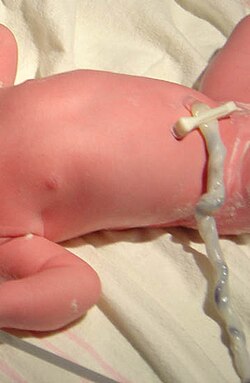
Back حبل سري Arabic ЦӀиналзул бакь AV Göbək ciyəsi Azerbaijani Пъпна връв Bulgarian নাভিরজ্জু Bengali/Bangla Kordenn ar begel Breton Pupčana vrpca BS Cordó umbilical Catalan Ĭ-dái CDO ناوکەپەتک CKB
| Umbilical cord | |
|---|---|
 Umbilical cord of a three-minute-old baby. A medical clamp has been applied. | |
| Details | |
| Identifiers | |
| Latin | funiculus umbilicalis |
| MeSH | D014470 |
| TE | cord_by_E6.0.2.2.0.0.1 E6.0.2.2.0.0.1 |
| Anatomical terminology | |
In placental mammals, the umbilical cord (also called the navel string,[1] birth cord or funiculus umbilicalis) is a conduit between the developing embryo or fetus and the placenta. During prenatal development, the umbilical cord is physiologically and genetically part of the fetus and (in humans) normally contains two arteries (the umbilical arteries) and one vein (the umbilical vein), buried within Wharton's jelly. The umbilical vein supplies the fetus with oxygenated, nutrient-rich blood from the placenta. Conversely, the fetal heart pumps low-oxygen, nutrient-depleted blood through the umbilical arteries back to the placenta.
- ^ "Umbilical". Online Etymology Dictionary. Archived from the original on 4 March 2016. Retrieved 27 March 2018.
© MMXXIII Rich X Search. We shall prevail. All rights reserved. Rich X Search